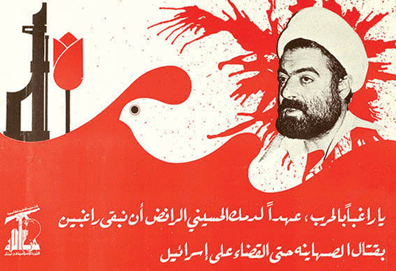
A poster commemorating the second anniversary of the assassination of Sheikh Ragheb Harb, by Merhi Merhi, 1986 (Hizballah Media Office)
by Hicham Safieddine, The Electronic Intifada, July 6
Author Christopher Hitchens might have saved himself a beating had he read Zeina Maasri’s book Off the Wall: Political Posters of the Lebanese Civil War. Hitchens, a self-proclaimed expert on all matters theological and Middle Eastern, was attacked in the streets of Beirut last February after defacing a political poster. The power of posters apparently touched Hitchens himself, who felt compelled to express his vindictiveness by attacking an image. But in a war-ravaged place like Lebanon, images can be a lot more than mere symbols. As Fawwaz Traboulsi explains in Off the Wall’s forward, they can serve as weapons, and Hitchens’ attackers must have understood that quite well.
The power of posters, as not merely symbolic weapons but also sites of hegemonic struggle during Lebanon’s civil war, is a central theme of Maasri’s book. A mix of text and image, the book is a rich and visually engaging work that tackles a dimension of war long-neglected by Lebanese historians. A sample of 150 posters (out of 700 the author has examined) in full color and printed on laminated paper occupies the center of the book and it is hard to begin reading before going through them: portraits of “heroic” leaders of all factions, clenched fists facing enemy guns, silhouettes of martyrs and landscapes of religious and nationalist symbols overlooked by dominant war figures, many marked with slogans that range from the racist to the revolutionary. But the book is a lot more than a slideshow of images summing up defining moments of the war or a straightforward critical review of the posters. Maasri delves into questions of theory, representation and meaning that shaped and defined the art of poster-making and the politics of their interpretation during times of conflict.
For the rest of this article, click here.